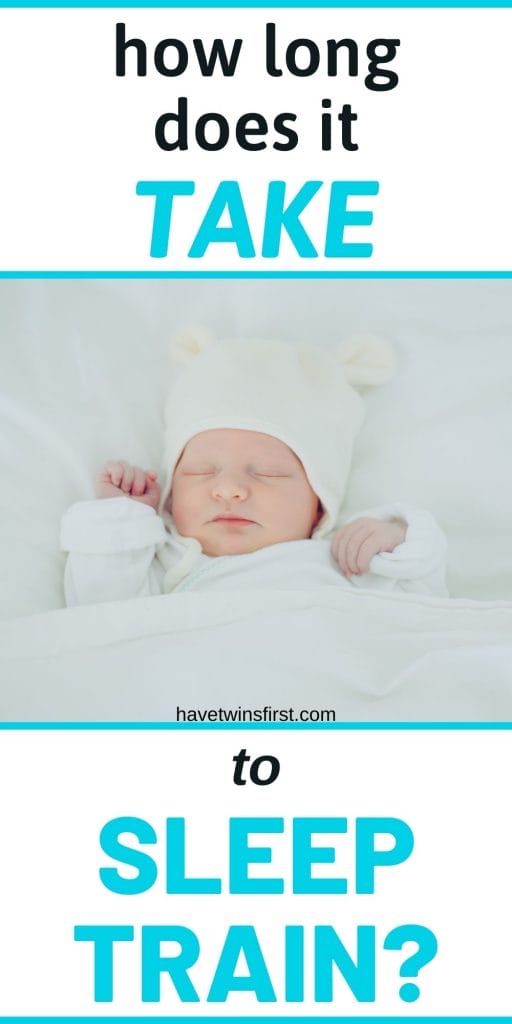The first year of a baby’s life is crucial in terms of nutrition and sleep. They need to have a good sleeping cycle because their brain and body are still in the developing phase.
Since babies grow rapidly during their early life, they must get enough sleep to play actively in the day. Having a good sleep routine improves the brain function and overall mental health of babies.
New parents are usually stressed out about their baby’s sleep routine. Some days they sleep peacefully but other days they cry and cry at bedtime. So, let’s discuss a few important points of sleep training babies, and also answer the question of how long does sleep training take?
Please note, there are affiliate links in this post. Read my disclosure policy to learn more.
What Is Baby Sleep Training?
When a baby is put to bed wide awake and he or she can go to sleep without being rocked, cuddled, or nursed, it means the baby has been sleep trained. A sleep trained baby can go back to sleep if he wakes up during the night.
A sleep trained baby tends to sleep more peacefully at night and also sleeps for a longer period of time. It is not necessary to sleep train a baby, but whenever parents feel comfortable enough they can start their baby’s sleep training.
When To Start Sleep Training a Baby?
The ideal time to start sleep training depends on your baby’s development, but it is recommended to start sleep training a baby between four to six months. Babies do not develop as many habits at this young age, so it becomes easier to sleep train them.
At 4 to 6 months old, babies can sleep for longer periods of time, i.e. 6 to 8 hours. This is another reason it makes it the best time to sleep train them. As babies get older, it will become more difficult to sleep train them because they start developing their habits and they will not be ready to learn to soothe themselves.
So, it is always better and easier to start sleep training early on to make your baby an independent sleeper. With that said, do not worry too much if your baby is older than 6 or 7 months. Many people successfully sleep train their babies or toddlers, even at 2 years old.
When Can Babies Sleep Through The Night?
For the purpose of this post, we are defining sleeping through the night as a baby having uninterrupted sleep for 6 to 9 hours. Many babies do not sleep through the night until they are 6 months or older.
Before this age they typically wake up for feedings. Even at 6 months old a baby might still wake up one or two times for milk, but he should be able to go back to sleep as soon as he has been fed.
For reference, when a baby is 0 to 3 months old, it is the most difficult time to keep him sleeping because he might wake up after every 2 hours to eat.
How Long Does Sleep Training Take?
The time required to fully sleep train a baby differs from baby to baby. For some parents, it takes 2 to 3 weeks to sleep train and for some parents, it takes 2 to 3 nights to sleep train the baby.
You will know that you have been successful in your mission when your baby starts sleeping through the night and does not need your support to fall asleep.
How Long Does Sleep Training Take For Naps?
Naps during the day are essential for the well-being and development of babies. Babies should take proper rest during the day because they are growing and developing at a rapid pace, which means they need their rest.
Some babies do not like to nap during the daytime and it is a battle to put them to a nap every day. For such babies, it is important to teach them how they can put themselves to sleep. It can take about a week to sleep train a baby for naps.
This is important to note because you might not be successful in sleep training at nap time right away. It’s important to keep working on sleep training at naptime, even after few days, until your baby gets the hang of putting himself to sleep and staying asleep.

Sleep Training Methods
It is every parent’s wish that their babies can go to sleep themselves and sleep through the night. However, every baby is different and what works for one baby might not work for the other one.
So, parents end up choosing different approaches for sleep training, according to what is best for their baby. Below we will review five different baby sleep training methods that you may wish to try out.
Ferber Method
The Ferber method is also known as the ‘check and console’ method, in which you do not let your baby cry too much. You only let your baby cry for a set period before you go and verbally try to soothe or pat the baby.
The time intervals can be 5, 10, 15 minutes, and so on. These time intervals keep increasing and the baby eventually falls asleep. Let’s discuss how you can do the Ferber method with your baby.
- Once your baby’s bedtime routine is complete, put your baby down awake but slightly drowsy but awake, and leave the room.
- Continue to monitor your baby (a video baby monitor can be very helpful).
- If your baby cries, wait for a few minutes before you go inside the room to check on him. Initially you can wait for about 5 minutes.
- When you re-enter the room, do not pick up your baby. Just try to console him and leave the room after 2 to 3 minutes even if your baby is still crying.
- If the crying continues, you can go into the room again but this time you will wait a bit longer, maybe 10 to 15 minutes before entering your baby’s nursery.
- Continue this cycle until your baby puts himself to sleep.
No-Cry Method
Sleep training a baby depends on the temperament of the baby. If a baby is cooperative there will be no issues, but if a baby is resistant then you will have to deal with fussiness.
Using the no-cry method can be difficult for parents of fussy babies. But, implementing this method decrease the amount of time your baby cries.
The no-crying sleep method takes a little longer to progress because parents have to give a lot of attention and comfort to their baby. Parents stay in the room for more time during bedtime, which helps their baby fall asleep without crying.
Let’s review how the no-cry sleep training method works.
- Establish a consistent schedule for daytime and nighttime sleep. Here is an example 6 month old schedule to help you out.
- Put your baby to sleep in his crib and leave the room.
- As soon as you hear your baby crying, immediately go inside the room and pick your baby up and soothe him.
- Once your baby settles again, put him back in the crib and let him fall asleep himself.
- With this practice for a few days, the baby will get used to sleeping like this.
Chair Method
The chair method is the ‘no tears’ technique in which the mother sits beside the crib on a chair and tries to soothe the baby while sitting next to him. It involves comforting your baby when needed and then gradually moving the chair close to the door and eventually out of the room.
In this method, the baby does not feel alone and learns the most important skill of self-soothing early. Parents who use this method for sleep training like it because they are able to stay close to their baby.
The chair method can take a few weeks until the baby gets used to self-soothing, so it is not an ideal method if you are looking for quick results. Let’s take a look at the process of putting your baby to sleep using the chair method.
- Perform the regular nighttime routine every day to familiarize your baby with sleep time.
- Place a chair right next to your baby’s crib.
- Put your baby in the crib while he is drowsy but still awake.
- Sit in the chair and tell your baby that it’s time to sleep.
- In the beginning, your baby will fuss a little before going to sleep. You can try to soothe him verbally or pat him a little.
- Do not interact too much, it might make your baby become fully awake.
- Leave the chair and go out of the room once your baby falls asleep.
- Repeat the process if your baby wakes up and fusses a little.
Cry It Out Method
The cry it out method includes several different methods which involve letting babies cry, and in turn, they will eventually learn to fall asleep. The parents decide a specific time to let their baby cry as much as they want. Once the time is over they go inside and check up on the baby and console them.
The cry it out method typically depends on the age of the baby and how much time parents want to take to get their baby sleep trained. Here’s how you can sleep train your baby using the cry it out method.
- Create a baby bedtime routine to let your baby know that it’s time to sleep.
- Place your baby in the crib, on his back, and leave the room.
- Make sure you are monitoring through a baby audio or video monitor to see what your baby is up to.
- If your baby cries, go into the room and try to soothe your baby verbally.
- Do not pick your baby up and try to console him.
- If your baby does not stop crying then lookout for clues, there might be something that is bothering your baby e.g. dirty diaper, teething, hunger, or colic pain.
- It might take a little longer to finally get your baby sleep trained but keep trying because consistency is the key.
Fading Method
The fading sleep training method allows your baby to decide his sleep time and what works best for him. If a baby is not ready to sleep then he will not go to sleep willingly.
Through the fading method, parents pay close attention to the cues that their baby gives that he is ready to sleep. The baby decides at which time he wants to sleep and thus goes to sleep in less time. This type of method can be time consuming, but it is worth it in the end.
Here’s how you can follow the fading method.
- Track your baby’s sleep time when he easily goes to sleep for a week. Make sure to track the time when your baby naturally falls asleep even if it is 10 pm.
- Look out for fussing, eye rubbing, and yawning, all these are signs that your baby is sleepy.
- When you see these signals, start your baby’s bedtime routine immediately.
- Put your baby in his crib and leave the room. If he cries a little do not go back. Maybe he will fall asleep.
- If the crying period gets too long then you would go and take your baby out of the nursery.
- Try putting him to bed again after 20 to 30 minutes.
- Eventually, your baby will settle at his natural bedtime and go to sleep.
My Sleep Trained Baby Is Waking Up Again: How Long Will Sleep Training Take This Time?
The biggest misconception that parents usually have is that they think they will have to sleep train only once. Just like any adult, babies can also sometimes have a tough time going to sleep.
There can be several reasons due to which a sleep-trained baby can no longer go to sleep on his own. It can be due to sleep regression, hitting a milestone, teething, getting sick, or even missing a nap.
But the good news is that this time it will take less time to sleep train your baby who has already been familiar with the process. You can expect it to take 2 to 3 days for your baby to regain his sleeping habits once again with some sleep training help.

Baby Sleep Training FAQ
New parents have many concerns about sleep training their babies and they want to educate themselves about every detail. Here we have answered some frequently asked questions about sleep training a baby.
Is Sleep Training Bad?
Scientific studies show that there is not much difference in the behavior, sleep quality, and the parent-child relationship of a baby who has been sleeping trained and a baby who has not been sleeping trained.
This means, sleep training is not at all bad for babies.
Can Sleep Training Be Implemented For Middle Of The Night Wakings?
Yes, it can be implemented to stop your baby from waking up at night out of habit. Gradually nighttime waking and feedings will decrease on their own.
What Should I Do If Baby Cries For Hours?
Babies tend to cry a lot during the first three months of their life. When the crying session continues for hours here is what you can do.
- Feed your baby.
- Look out for signs of pain, dirty diapers, or irritation. If there is a problem, address it.
- Try all the tips and tricks to soothe your baby.
- If there is no apparent reason for crying too much, and after trying all the things that you can, you might decide to let your baby cry.
Is Letting A Baby Cry It Out Dangerous?
When a baby is healthy and there is no medical reason for crying, then it is totally fine for babies to cry their hearts out. Crying does not create behavioral or medical problems for a baby.
What Should I Do If Sleep Training is Not Working After 2 Weeks?
You spent hours researching sleep training techniques, and it still did not work for you. Here are a few reasons to consider why it did not work.
Naps are important
Sleep training does not mean that you have to sleep train your baby for the night time only. Daytime naps are equally important for babies.
Having the same schedule for many days will help your baby to be sleep trained. The way you put your baby down for naps is also very important, so do not forget to put your baby to nap and have a routine when you do.
Consistency is the key
With babies and toddlers, consistency is pretty much the key for everything. Babies tend to familiarize themselves with things and people very easily. They also tend to adapt or change habits easily as well.
So, it is important to follow a schedule every day (or at least most days).
Do not run to calm down your baby
It is not good for sleep training that whenever a baby starts fussing their parents run to soothe him. Give your baby a minute and see if he can self-soothe and go back to sleep without being held.
Put baby to sleep earlier
It has been shown that sometimes a baby needs an earlier bedtime. Often this can improve your baby’s quality of sleep and also help your baby sleep through the night uninterrupted.
How Do I Handle Being Scared To Start Sleep Training?
It is normal for new parents to be scared to start sleep training their babies. Mostly because they are so used to nursing, rocking, or patting their baby when they put them to sleep.
Let’s discuss a few suggestions to overcome this fear.
- Believe in yourself and your decision. Only parents can decide what is best for their baby and when they think it’s time to sleep train their baby.
- Sleep training your baby does not make you a bad mother or father. In fact, it can help everyone in the family’s sanity because it can lead to the entire household getting enough sleep.
- Sleep training is a revolution in the parenthood journey and it make a parent’s life easier.
- If you are not ready to sleep train your baby, then do not try it yet. Give yourself some time to think about it. If you move forward with sleep training before you are ready, there is a good chance you will not be successful.
Can You Sleep Train and Still Nurse At Night?
Yes, absolutely. You can still nurse your baby while sleep training. Eventually, as your baby gets used to sleeping on his own, night waking and feedings will likely decrease naturally.
Is Sleep Training a Baby Worth It For How Long It Takes?
It is the wish of every parent to get their babies to a point where they do not need support to sleep. Some form of baby sleep training is often the best option for parents to get to this point.
Sleep training a baby is totally normal and it is not harmful at all. There are several different methods and techniques that can be used for sleep training. Parents can select a sleep training method according to their preference and what works best for them.
Keep in mind, sleep training a baby is typically not a one-time job. Parents might have to repeat the process many times. But, with a little patience and consistency babies are often able to start sleeping without any help.






